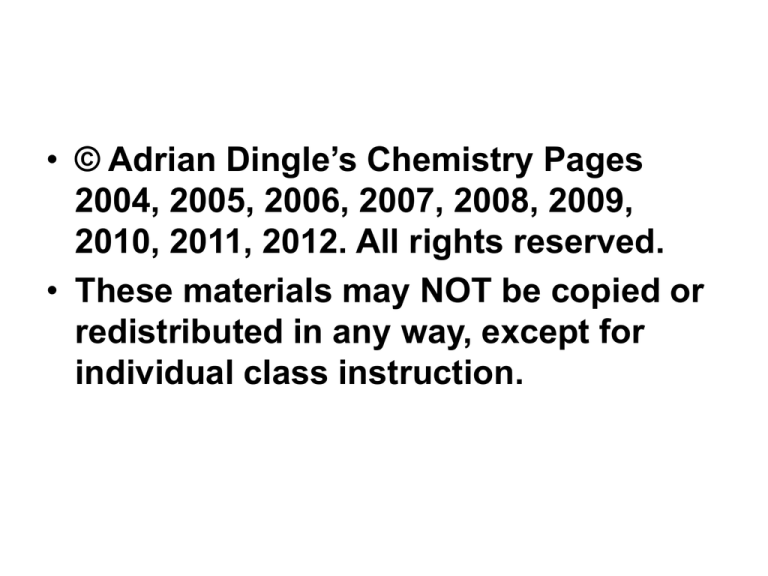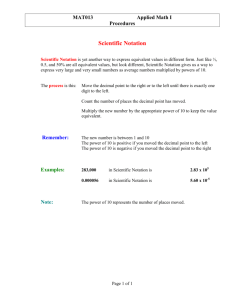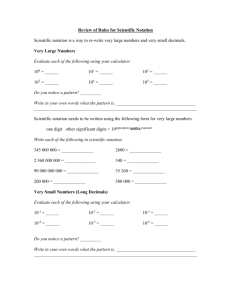
• © Adrian Dingle’s Chemistry Pages
2004, 2005, 2006, 2007, 2008, 2009,
2010, 2011, 2012. All rights reserved.
• These materials may NOT be copied or
redistributed in any way, except for
individual class instruction.
What is Chemistry?
• Chemistry can be described as the
science that deals with matter, and the
changes that matter undergoes.
• It is sometimes called the central science
because so many naturally occurring
phenomena involve chemistry and
chemical change.
Scientific Problem Solving
Scientific (logical) problem solving involves several
steps:
1. State the problem and make observations.
Observations can be quantitative (those
involving numbers or measurement) or
qualitative (those not involving numbers).
2. Formulate a possible solution (this is a
hypothesis).
3. Perform experiments to test the hypothesis. The
results and observations from these experiments
lead to the modification of the hypothesis and
therefore further experiments.
Scientific Problem Solving
• Eventually after several experiments the
hypothesis may graduate to become a
theory.
• A theory gives a universally accepted
explanation of the problem. Of course,
theories should be constantly challenged
and may be refined as and when new data
and new scientific evidence comes to light.
Scientific Problem Solving
• Theories are different to laws. Laws state
what general behavior is observed to
occur naturally.
• For example The Law of Conservation of
Mass exists since it has been consistently
observed that during all chemical changes
mass remains unchanged (i.e. it is neither
created nor destroyed).
Measurement
• Measurements, and subsequently
calculations, allow the determination of
some of the quantitative properties of a
substance.
• For example, mass and density.
Scientific notation
• Measurements and calculations in
chemistry often require the use of very
large or very small numbers. In order to
make handling them easier, such numbers
can be expressed using scientific notation.
• All numbers expressed in this manner are
represented by a number between 1 and
10 multiplied by 10 raised to a power.
Scientific notation
• The number of places the decimal point
has moved determines the power of 10. If
the decimal point has moved to the left
then the power is positive, to the right,
negative.
• For example, the number 42000 is converted to
scientific notation by using the number 4.2. In
the process the decimal point has moved four
places to the left, so the power of 10 used is +4.
42000 = 4.2 x 104
• The number 0.00012 on the other hand, is
converted to scientific notation by using the
number 1.2. In the process the decimal point has
moved four places to the right, so the power of
10 used is -4.
0.00012 = 1.2 x 10-4
Scientific Notation Practice
• Convert the following numbers to
scientific notation.
(a) 24500
(b) 356
(c) 0.000985
(d) 0.222
(e) 12200
Scientific Notation Practice
• Convert the following scientific notation
numbers to non-scientific notation
numbers.
(a) 4.2 x 103
(b) 2.15 x 10-4
(c) 3.14 x 10-6
(d) 9.22 x 105
(e) 9.57 x 102
SI Units
• Units tell us the scale that is being used
for measurement. Prefixes are used to
make writing very large or small numbers
easier.
SI Units
• Common SI units and prefixes are given below.
• Base Quantity Name of Unit Symbol
Mass
Kilogram
kg
Length
Meter
m
Time
Second
s
Amount of Substance
Mole
mol
Temperature
Kelvin
K
Metric System
Prefix
Giga
Mega
Kilo
Base
Deci
Centi
Milli
Micro
Nano
Pico
Symbol
G
M
k
d
c
m
u
n
p
Meaning
109
106
103
100
10-1
10-2
10-3
10-6
10-9
10-12
Converting Units
• One unit can be converted to another by
using a conversion factor. Application of
the simple formula below will allow the
conversion of one unit to another. This
method of converting between units is
called the factor-labeling method or
dimensional analysis.
Converting Units
• (Unit a) (conversion factor) = Unit b
• The conversion factor is derived from the
equivalence statement of the two units.
For example, in the equivalence of 1.00
inches = 2.54 cm, the conversion factor
will either be,
Converting Units
• The correct choice is the one that allows
the cancellation of the unwanted units.
For example, to convert 9.00 inches into
cm, do the following calculation:
9 inch
2.54 cm
1.00 inch
= 22.9 cm
Converting Units
• To convert 5.00 cm into inches, do the
following calculation:
5.00 cm
1.00 inch
2.54 cm
= 1.97 inches
Temperature
• There are three scales of temperature that
you may come across in your study of
chemistry. They are Celsius (oC),
Fahrenheit (oF) and Kelvin (K).
• The conversion factors on the next slide
will be useful.
Temperature
Examples
• Convert the following quantities from one unit
to another using the following equivalence
statements. Clearly show working.
• 1.000 m = 1.094 yd
• 1.000 mile = 1760 yd
• 1.000 kg = 2.205 lbs
(a) 30 m to miles
(b) 1500 yd to miles
(c) 206 miles to m
(d) 34 kg to lbs
(e) 34 lb to kg
Examples
• Convert the following temperatures
from one unit to the other.
(a) 263 K to oF
(b) 38 K to oF
(c) 13 oF to oC
(d) 1390 oC to K
(e) 3000 oC to oF
Derived Units
• All other units can be derived from base
quantities. One such unit that is very
important in chemistry is volume. Volume
has the unit length3. Common units for
volume are Liters (L) or milliliters (mL).
• 1.000 mL = 1.000 cm3
• 1.000 L = 1000. mL = 1000. cm3 = 1.000 dm3
Density
• Density is the ratio of the mass of an
object to its volume.
Density Examples
• A small gold nugget has volume of 0.87
cm3. What is its mass if the density of
gold is 19.3 g/cm3?
• What volume is occupied by 35.2 g of
carbon tetrachloride if its density is 1.60
g/mL?
Uncertainty, Significant figures and Rounding off
• When reading the scale on a piece of laboratory
equipment such as a graduated cylinder or a
buret, there is always a degree of uncertainty in
the recorded measurement.
• The reading will often fall between two divisions
on the scale and an estimate must be made in
order to record the final digit. This estimated final
digit is said to be uncertain and is reflected in the
recording of the numbers by using +/-. All those
digits that can be recorded with certainty are
said to be certain.
• The certain and the uncertain numbers taken
together are called significant figures.
Determining the number of significant
figures present in a number
1. Any non-zero integers are always
counted as significant figures.
2. Leading zeros are those that precede all
of the non-zero digits and are never
counted as significant figures.
3. Captive zeros are those that fall
between non-zero digits and are always
counted as significant figures.
Determining the number of significant
figures present in a number
4. Trailing zeros are those at the end of a
number and are only significant if the number
is written with a decimal point.
5. Exact numbers have an unlimited number of
significant figures. (Exact numbers are those
which are as a result of counting e.g. 3 apples
or by definition e.g. 1.000 kg = 2.205 lb).
6. In scientific notation the 10x part of the number
is never counted as significant.
Determining the correct number of
significant figures to be shown as the
result of a calculation
1. When multiplying or dividing. Limit the answer
to the same number of significant figures
that appear in the original data with the
fewest number of significant figures.
2. When adding or subtracting. Limit the answer
to the same number of decimal places that
appear in the original data with the fewest
number of decimal places.
Rounding off
• In a multi-step calculation it is possible to
leave the rounding until the end i.e. leave
all numbers on the calculator in the
intermediate steps, or round to the correct
number of figures in each step, or round to
an extra figure in each intermediate step
and then round to the correct number of
significant figures at the end of the
calculation.
Rounding off
• Whichever method is being employed, use
the simple rule that if the digit directly to the
right of the final significant figure is:
• less than 5 then the preceding digit stays
the same.
• perfectly equal to 5 (without any more
nonzero digits) then the preceding digit
should be rounded to the nearest even digit
• 5 with nonzero digits trailing then the
preceding digit should be increased by one.
Sig Fig Examples
• Determine the number of significant
figures in the following numbers.
(a) 250.7
(b) 0.00077
(c) 1024
(d) 4.7 x 10-5
(e) 34000000
Sig Fig Examples
• Using a calculator carry out the following
calculations and record the answer to the
correct number of significant figures.
(a) 34.5 x 23.46
(b) 123 / 3
(c) 2.61 x 10-1 x 356
(d) 21.78 + 45.86
(e) 23.888897 - 11.2
(f) 6 - 3.0
Accuracy and Precision
• A distinction should be made between
accuracy and precision.
• Accuracy relates to how close the
measured value is to the actual value of
the quantity.
• Precision refers to how close two or more
measurements of the same quantity are to
one another.
Accuracy and Precision
• Consider three sets of data that have been
recorded after measuring a piece of wood
that is exactly 6.000 m long.
(a) Which set of data is the most accurate?
(b) Which set of data is the most precise?
Percentage Error
• The data that is derived from experiments
will often differ from the accepted,
published, actual value. When this occurs,
a common way of expressing accuracy is
percentage error.
Percentage Error
• Determine the percentage error in the
following problem. Show all your work!
Experimental Value: 1.14 g
Actual Value: 1.30 g







